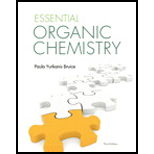
Concept explainers
Draw the structure for each of the following:
- a. isobutyraldehyde
- b. diisopentyl
ketone - c. 3-methylcyclohexanone
- d. 2,4-pentanedione
- e. 4-bromo-3-heptanone
- f. 4-bromohexanal
(a)
Interpretation:
The structure of Isobutyraldehyde has to be drawn.
Concept Introduction:
For any given organic compound name, the corresponding structure can be analysed and drawn by analysing or identifying the following aspects of the name:
- Parent chain.
- Functional group.
- Position of the functional group on the parent chain.
- Alkyl substituent.
- Position of the alkyl substituent on the parent chain.
Answer to Problem 28P
The structure of Isobutyraldehyde is given below:
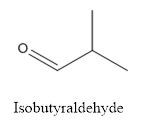
Explanation of Solution
The compound has aldehyde group that is attached to the isobutyl group.
The structure of isobutyraldehyde is as follows.

(b)
Interpretation:
The structure of diisopentyl ketone has to be drawn.
Concept Introduction:
For any given organic compound name, the corresponding structure can be analysed and drawn by analysing or identifying the following aspects of the name:
- Parent chain.
- Functional group.
- Position of the functional group on the parent chain.
- Alkyl substituent.
- Position of the alkyl substituent on the parent chain.
Answer to Problem 28P
The structure of diisopentyl ketone is given below:
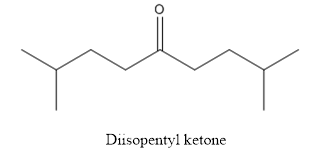
Explanation of Solution
The compound has ketone functional group. Two isopentyl groups are attached to the keto group.
The structure of diisopentyl ketone is as follows.

(c)
Interpretation:
The structure of 3-methylcyclohexanone has to be drawn.
Concept Introduction:
For any given organic compound name, the corresponding structure can be analysed and drawn by analysing or identifying the following aspects of the name:
- Parent chain.
- Functional group.
- Position of the functional group on the parent chain.
- Alkyl substituent.
- Position of the alkyl substituent on the parent chain.
Answer to Problem 28P
The structure of 3-methylcyclohexanoneis given below:

Explanation of Solution
The compound has ketone functional and group and it is cyclohexanone that has one methyl group at 3rd position of the cyclic ring.
The structure of 3-methyl cyclohexanone is as follows.

(d)
Interpretation:
The structure of 2,4-pentanedione has to be drawn.
Concept Introduction:
For any given organic compound name, the corresponding structure can be analysed and drawn by analysing or identifying the following aspects of the name:
- Parent chain.
- Functional group.
- Position of the functional group on the parent chain.
- Alkyl substituent.
- Position of the alkyl substituent on the parent chain.
Answer to Problem 28P
The structure of 2,4-pentanedione is given below:
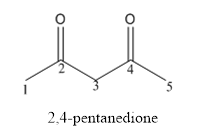
Explanation of Solution
The compound has two keto functional groups and these are attached to the pentane carbon chain.
The structure of 2,4-pentanedione is as follows:

(e)
Interpretation:
The structure of 4-bromo-3-heptanone has to be drawn.
Concept Introduction:
For any given organic compound name, the corresponding structure can be analysed and drawn by analysing or identifying the following aspects of the name:
- Parent chain.
- Functional group.
- Position of the functional group on the parent chain.
- Alkyl substituent.
- Position of the alkyl substituent on the parent chain.
Answer to Problem 28P
The structure of 4-bromo-3-heptanone is given below:
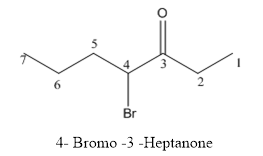
Explanation of Solution
The compound has keto functional group and it is attached to the heptane carbon chain. At the 4th position of the carbon chain has bromine attachment.

(f)
Interpretation:
The structure of 4-bromohexenal has to be drawn.
Concept Introduction:
For any given organic compound name, the corresponding structure can be analysed and drawn by analysing or identifying the following aspects of the name:
- Parent chain.
- Functional group.
- Position of the functional group on the parent chain.
- Alkyl substituent.
- Position of the alkyl substituent on the parent chain.
Answer to Problem 28P
The structure of 4-bromohexenal is given below:

Explanation of Solution
The compound has bromine functional group at the 4th position from the aldehyde functional group on the hexane parent chain.
The structure of 4-bromohexenal is as follows:

Want to see more full solutions like this?
Chapter 12 Solutions
Pearson eText for Essential Organic Chemistry -- Instant Access (Pearson+)
- Explain the importance of having a sampling plan with respect to food analysis. Explain the importance of having a sampling plan with respect to food analysis. Provide examples.arrow_forwardPlease predict the products for each of the following reactions. Clearly show the regiochemistry (Markovnikov vs anti-Markovnikov) and stereochemistry (syn- vs anti- or both). If a mixture of enantiomers is formed, please draw all the enantiomers. cold KMnO4, NaOH 2. DMS 1. 03 CH3OH Br2 1. 03 2. (CH3)2S H₂ Pd or Pt (catalyst) HBr 18 19 20 1 HBr ROOR (peroxide) H₂O H₂SO4 HCI HI 17 16 6 15 MCPBA 1. BH3 THF 2. H₂O2, NaOH 1. OsO4 2. H₂O₂ 110 CH3CO₂H (peroxyacid) 1. MCPBA 2. H₂O* Br2 H₂O BH3 THF B12 EtOH Pd or Ni (catalyst) D₂ (deuterium) Bra A B C D H OH H OH OH H OH α α α OH H OH OH фон d H "Harrow_forwardBriefly indicate the models that describe the structure of the interface: Helmholtz-Perrin, Gouy-Chapman, Stern and Grahame models.arrow_forward
- Using Benzene as starting materid show how each of the Following molecules Contel Ve syntheswed CHI 9. b -50311 с CHY 503H Ночто d. อ •NOV e 11-0-650 NO2arrow_forwardThe molecule PYRIDINE, 6th electrons and is therefore aromatre and is Assigned the Following structure contering Since aromatk moleculoy undergo electrophilic anomatic substitution, Pyridine shodd undergo The Following reaction + HNO3 12504 a. write all of the possible Mononitration Products that could Result From this reaction 18. Bared upon the reaction mechanison determime which of these producty would be the major Product of the hegetionarrow_forwarda. Explain Why electron withdrawing groups tend to be meta-Directors. Your answer Should lyclude all apropriate. Resonance contributing Structures fo. Explain why -ll is an outho -tura drccton even though chlorine has a very High Electronegativityarrow_forward
 ChemistryChemistryISBN:9781305957404Author:Steven S. Zumdahl, Susan A. Zumdahl, Donald J. DeCostePublisher:Cengage Learning
ChemistryChemistryISBN:9781305957404Author:Steven S. Zumdahl, Susan A. Zumdahl, Donald J. DeCostePublisher:Cengage Learning ChemistryChemistryISBN:9781259911156Author:Raymond Chang Dr., Jason Overby ProfessorPublisher:McGraw-Hill Education
ChemistryChemistryISBN:9781259911156Author:Raymond Chang Dr., Jason Overby ProfessorPublisher:McGraw-Hill Education Principles of Instrumental AnalysisChemistryISBN:9781305577213Author:Douglas A. Skoog, F. James Holler, Stanley R. CrouchPublisher:Cengage Learning
Principles of Instrumental AnalysisChemistryISBN:9781305577213Author:Douglas A. Skoog, F. James Holler, Stanley R. CrouchPublisher:Cengage Learning Organic ChemistryChemistryISBN:9780078021558Author:Janice Gorzynski Smith Dr.Publisher:McGraw-Hill Education
Organic ChemistryChemistryISBN:9780078021558Author:Janice Gorzynski Smith Dr.Publisher:McGraw-Hill Education Chemistry: Principles and ReactionsChemistryISBN:9781305079373Author:William L. Masterton, Cecile N. HurleyPublisher:Cengage Learning
Chemistry: Principles and ReactionsChemistryISBN:9781305079373Author:William L. Masterton, Cecile N. HurleyPublisher:Cengage Learning Elementary Principles of Chemical Processes, Bind...ChemistryISBN:9781118431221Author:Richard M. Felder, Ronald W. Rousseau, Lisa G. BullardPublisher:WILEY
Elementary Principles of Chemical Processes, Bind...ChemistryISBN:9781118431221Author:Richard M. Felder, Ronald W. Rousseau, Lisa G. BullardPublisher:WILEY





